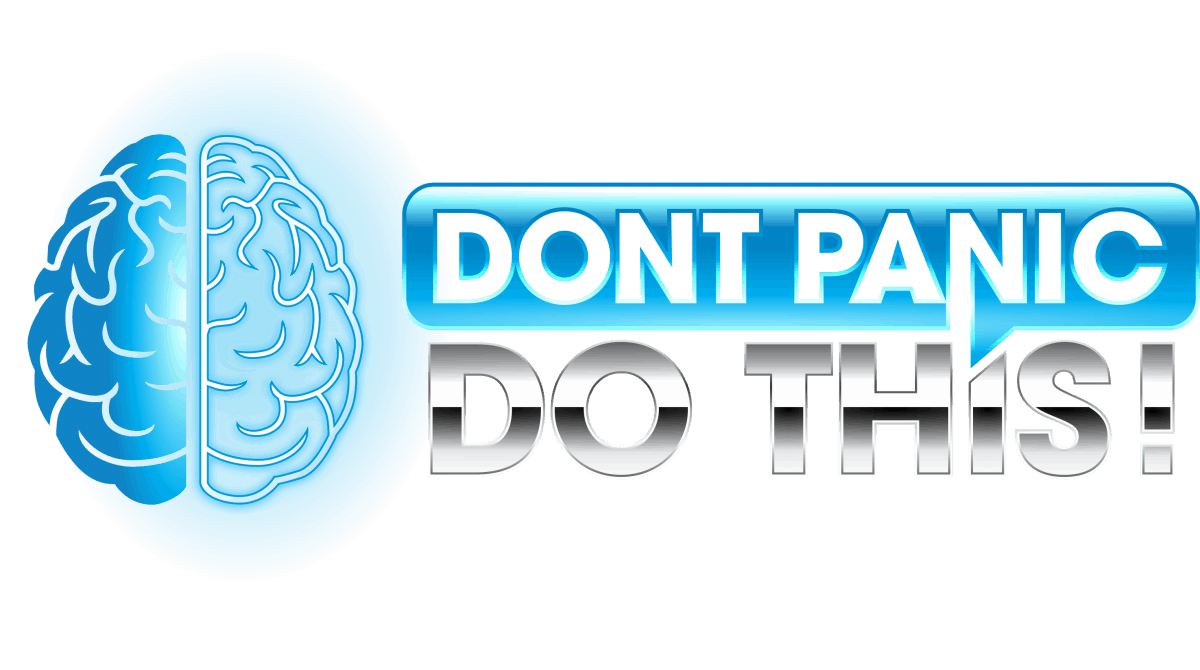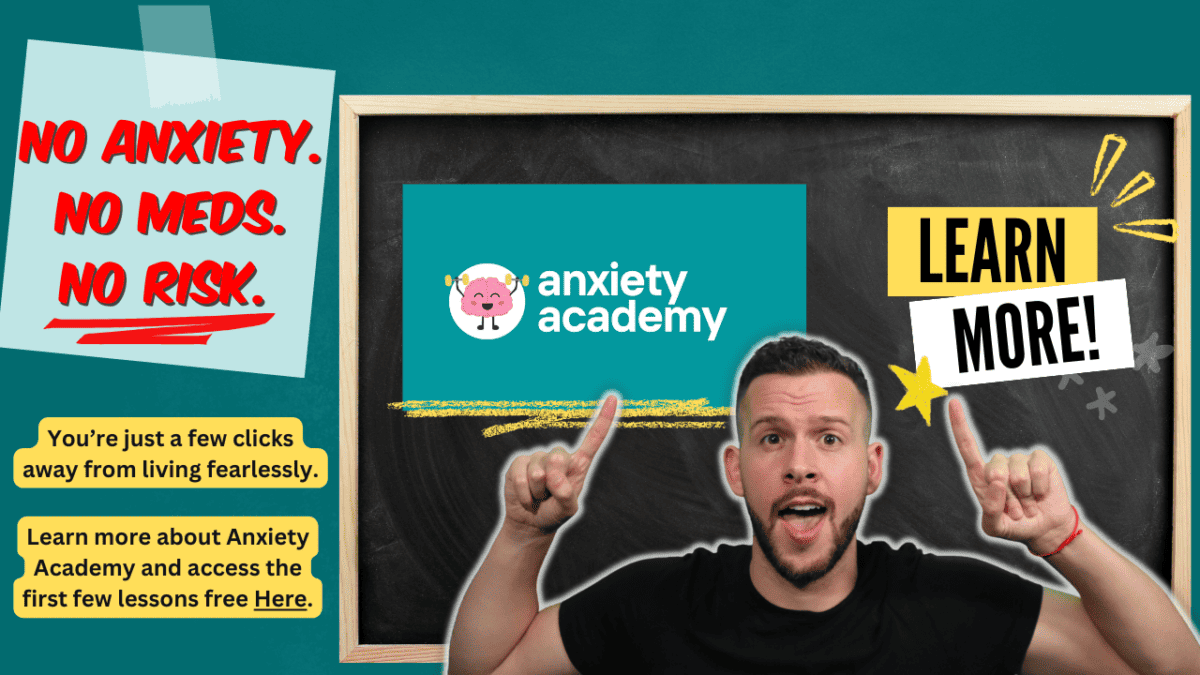When mental health issues have you feeling helpless, you may wonder how to get FMLA for anxiety. Fortunately, the Family and Medical Leave Act (FMLA) process is relatively straightforward and easy. Here are the steps required to get FMLA for anxiety:
- Check that you are eligible for FMLA (employer size, months worked, hours worked)
- Make sure your reason or condition qualifies for FMLA (anxiety disorder, birth, etc.)
- Inform your employer of your need for leave (ideally 30 days prior to start date)
- Be able to provide medical certification within 15 days of requesting leave
Having gone through the FMLA process for anxiety myself, I realize it can feel overwhelming.
No worries… I’ll walk you through each step and share some useful tips along the way!
P.S. If you're struggling with anxiety, you're in the right place. After reading this article, check out this page to learn how to start beating anxiousness once and for all!
(Just remember, I’m not a lawyer and this is not legal advice. Do your due diligence!)
How to Get FMLA for Anxiety (4 Easy Steps)
What is FMLA?
FMLA (The Family and Medical Leave Act) is a US labor law requiring covered employers to provide up to 12 weeks of unpaid leave over a 12-month span for certain conditions or events. The employer cannot drop health insurance coverage or fire the employee throughout this leave.
There are a few different kinds of FMLA. I’ll try to make it simple:
Unpaid Leave: The bare minimum required by law. You maintain your job and benefits; unpaid.
Paid Leave: Some employers may apply your available PTO toward FMLA leave; policies vary.
Continuous Leave: Taking your full leave (up to 12 weeks in a 12-month period) at once.
Reduced Schedule Leave: Continuing to work through leave but on a reduced schedule basis.
Intermittent Leave: Taking leave in increments (days or hours at a time). You may be eligible if your condition requires ongoing treatment.
Later, I’ll explain how to work with your healthcare provider to get the type of leave you need.
Step 1: Do I Qualify for FMLA?
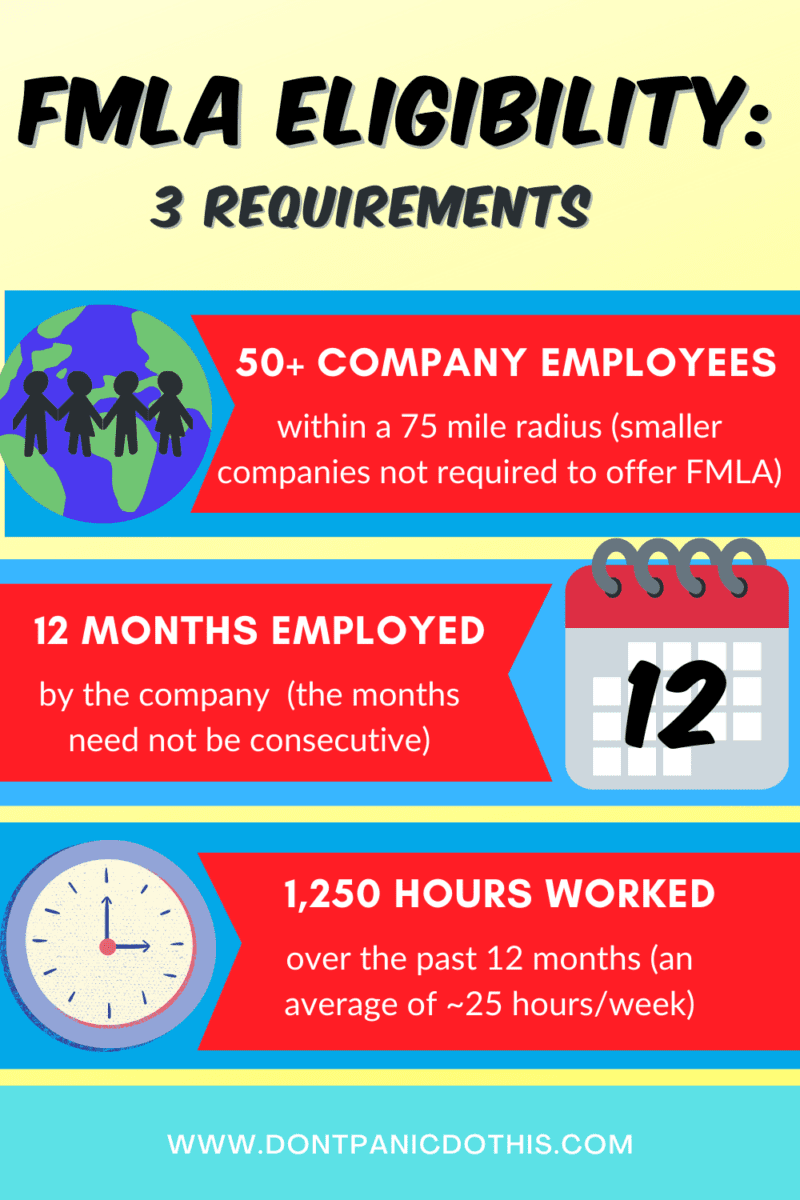
Before you waste your time reading any further, let’s get this important question out of the way.
To qualify for FMLA benefits, an employee must:
- Work for an employer with at least 50 employees in a 75-mile radius
- Have worked for the employer for at least a year (12 months total; non-consecutive counts)
- Have worked a minimum of 1,250 hours over the last 12 months (an average of about 25 hours per week)
Part-time employees may be eligible for FMLA. Like full-time employees, they will need to have worked at least 1,250 hours over the past year to be eligible.
Step 2: Does My Condition Qualify for FMLA?
There are four circumstances that can qualify you for FMLA:
- Serious Health Conditions
- Birth, Adoption, Foster Care Placement, and Bonding with a Child
- Military Family Leave
- Mental Health Conditions
If you or a spouse, child, or parent you are caring for are experiencing a serious health condition (this includes mental health conditions), you may be eligible for FMLA for mental health.
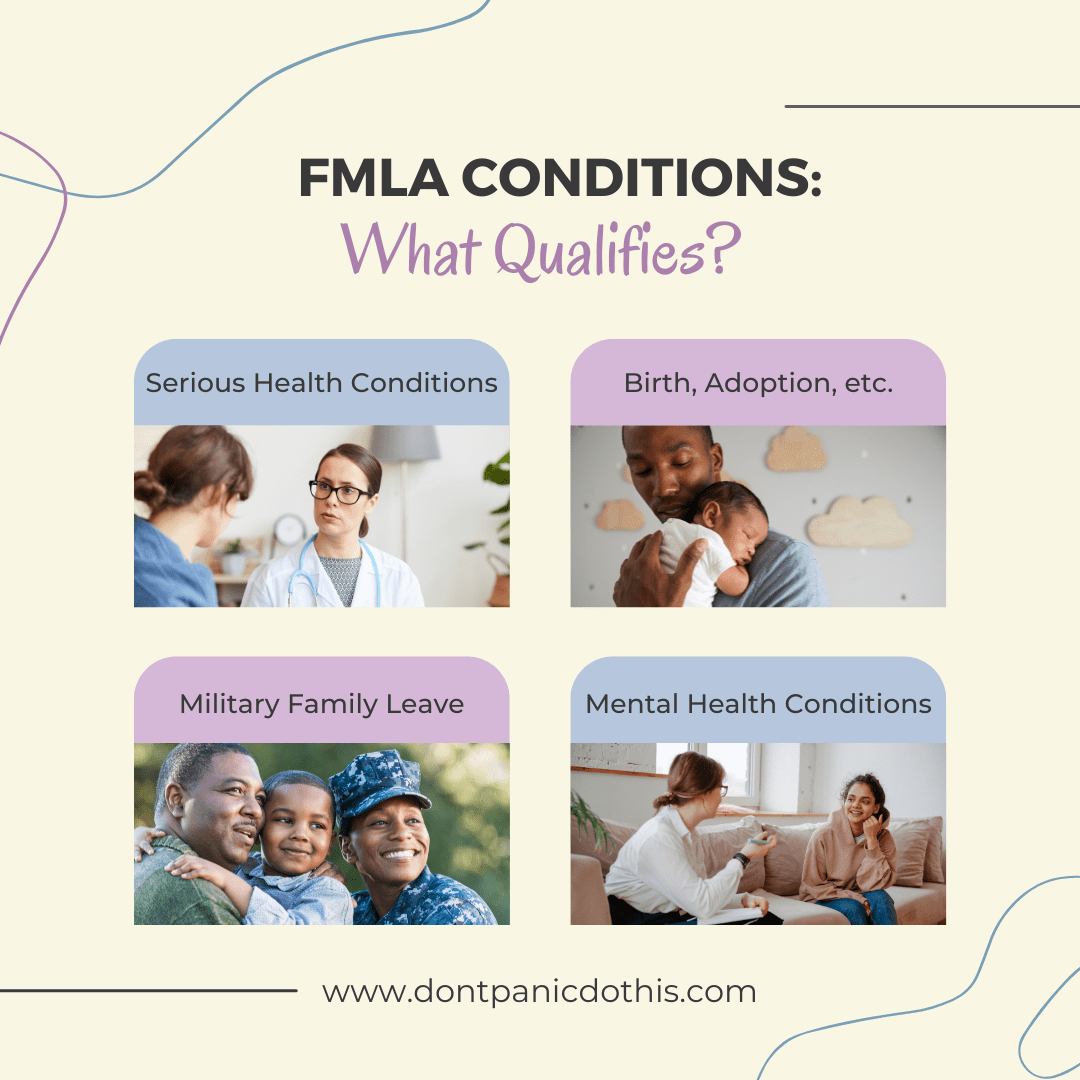
What makes a mental health condition “serious” enough to be eligible for FMLA?
Well, if you're dealing you're seeking FMLA for mental health for yourself (as opposed to taking it to care for someone else), here's what the U.S. Department of Labor says:

More specifically, you should qualify if your anxiety or mental health condition:
- Requires Inpatient Care: For example, an overnight stay in a hospital or treatment facility. This could be common for eating disorders and addiction issues.
- OR Requires Continuing Treatment:
- Incapacitation for Over 3 Consecutive Days; Requiring Ongoing Medical Treatment or Follow-Up Care (therapy, medication, counseling)
- Chronic Conditions (anxiety, depression) with Occasional Incapacitation; Treatment at Least Twice Per Year
Tip: I know this looks complicated, but don’t overthink it!
For chronic mental health conditions like anxiety, “continuing treatment” could be as simple as a quick chat with a mental health professional every 6 months.
Step 3: How to Tell Your Employer You Need Leave
*Extremely important Tip*
Once you start this step, you will have 15 days to provide certification from a healthcare professional (doctor, therapist, etc.) to validate your need to take leave. It may be wise to schedule an appointment with this professional before that 15-day timer starts.
(I wound up having to overpay at an out-of-coverage provider trying to meet my deadline.)
Starting the FMLA process for anxiety (or any condition) will look like this:
- Let your employer know you’ll need leave 30 days in advance (or as soon as possible)
- Your employer has five days to let you know whether or not you’re are eligible for FMLA
- You must submit a completed medical certification within 15 days
- Your employer has five days to let you know if your leave has been designated as FMLA
- You must follow your employer’s procedure for calling out of work using FMLA leave
- When you return from FMLA, your employer must return you to your same (or nearly the same) job
Tip: Remember to follow your employer’s policy for calling out of work. You may be required to call out of work (designating the callout as FMLA-related). You may also be required to follow up with a third-party responsible for handling your company’s leaves of absence.
For example, I had to report each intermittent absence through Sedgwick (below) in addition to following regular callout procedures with my employer:
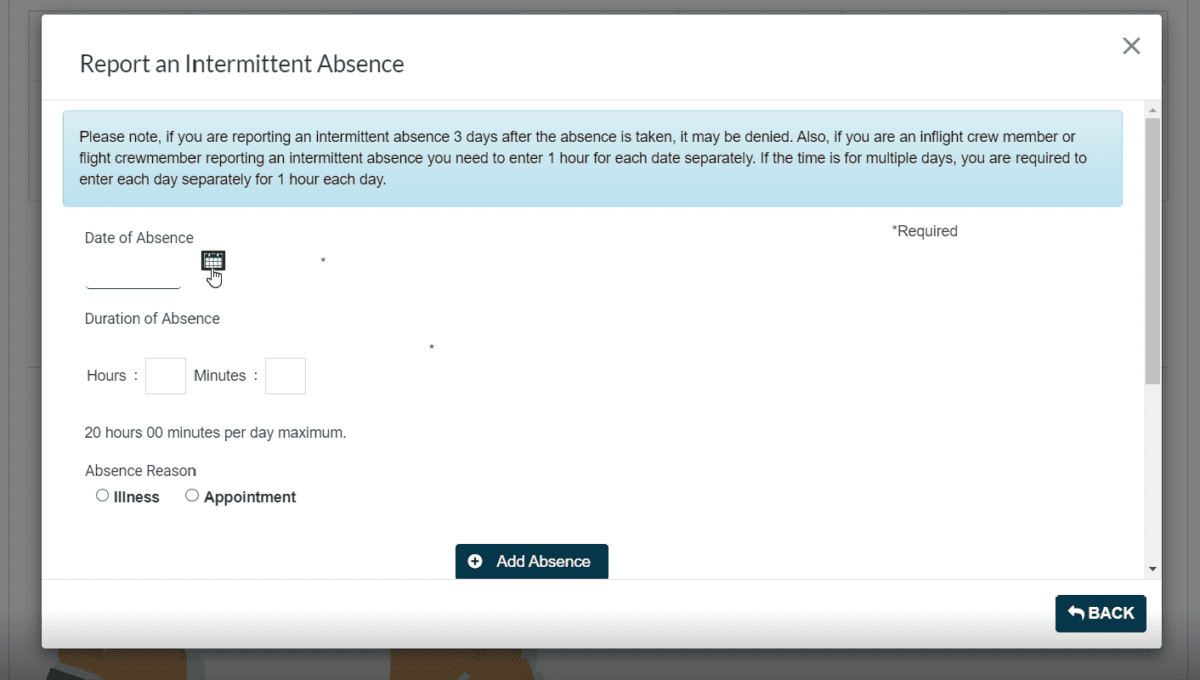
Step 4: Providing Medical Certification
Remember, once your employer requests medical documentation of your need for leave, the 15-day timer starts. You’ll need to provide medical certification from your healthcare provider by then. I recommend getting an appointment scheduled with your doctor or therapist before initiating the process with your employer.
In fact, you could even get the medical certification filled out before initiating the process with your employer. You can download the paperwork from the U.S. Department of Labor here.
Your employer may send you their own custom form for this. You may use their form if you wish, but they cannot deny your claim for deciding to use the standard, official documentation instead. Either way, bring the forms to your provider. Speak to them about what you’re going through, and tell them how FMLA would help you. Don’t be afraid to let them know exactly what kind of FMLA you’re hoping for.
If you’re applying for FMLA for anxiety, some therapists will even do this process with you by phone or video call. They may let you email them the necessary paperwork and fill it out for you.
With the medical certification in hand, you can submit it to your employer and be approved or denied for FMLA within five days.
If all goes smoothly, at this point… Congrats, you’ve successfully been approved for FMLA for anxiety!
Bonus: What to Say to Your Therapist to Get FMLA
From personal experience, my advice here is this:
Think hard about what kind of FMLA leave you need before you so much as schedule an appointment with a therapist or healthcare provider.
You know your needs better than anyone. It’s perfectly okay to express these specific needs to your therapist. After all, their recommendation can determine how much and how often you are allowed to call out using FMLA.
For example:
- Do severe panic attacks cause you to call out on random days throughout the month?
- Does depression make it hard for you to work for a week or two at a time?
- Are you going through something rough right now and need a few months off?
How I got FMLA for Anxiety (Personal Story)
When I went through the FMLA process for anxiety, I made sure to find someone who would work with my needs.
I emailed her office before booking anything and said:
“I’m going through something right now and would like FMLA so I can call out of work as needed from time to time. The paperwork is due in two weeks. Is that something you could help me with given the timeframe?”
The therapist I spoke to was more than happy to complete the paperwork within my time frame (as opposed to requiring me to work with her for months beforehand). I scheduled a call with her a few days later (I didn’t even have to go into the office).
I told my provider exactly what I needed, and why. In my case, I said:
“Something traumatic happened recently that has been causing me to feel more anxious than usual. I get random panic attacks that interfere with my ability to do my job. I don’t want to quit, but it would be helpful just to know I have the ability to call out of work on rough days as needed.”
The therapist was more than happy to fill out the paperwork in such a way that would allow me a ton of flexibility. After submitting her certification to my employer, I was approved for six months of Intermittent leave. I was allowed to call out using FMLA twice per month, for one week at a time (my therapist worked with me to suggest these numbers, yours may differ as needed).
After six months, I no longer needed FMLA and did not renew it. If it were needed, I could have booked another appointment with my therapist and extended my FMLA eligibility.
What Happens if An Employee is Not Eligible for FMLA?
If an employee is not eligible for FMLA, there are still some other options they may consider.
- Vacation, Paid Time Off (PTO), and Unpaid Time off (UTO)
- Disability Leave
- Stress Leave from Work
Disability vs FMLA
The main difference between disability leave and FMLA is that disability leave offers little to no job security, whereas FMLA protects you from being fired while away. It can be harder for some people to be approved for FMLA leave, especially if you work low hours, are new to the company, or work for a smaller company (under 50 people).
Disability leave refers to time taken off work due to a physical or mental disability. Disability leave may be paid or unpaid, depending on the situation and employer policies. Sometimes disability leave may be paid through PTO or sick leave. It could also sometimes be paid through a long-term or short-term disability insurance policy.
FMLA is a continuous, intermittent, or reduced hours leave to help protect the job of employees who need some time off for family or medical reasons.
Stress Leave vs FMLA
The main difference between stress leave and FMLA?
FMLA is a federal law protecting employees’ jobs while on leave for qualifying family or medical issues.
Stress leave is essentially just sick leave that is taken due to mental health reasons. While stress leave is not federally required by law, it’s often offered by employers and taken out of the employee’s sick days or PTO. Some states do have laws that require employers to provide a certain amount of PTO or UTO, which may be used for stress-related issues.
Can you get FMLA for Depression?
Like with anxiety, you can get FMLA for depression if it’s considered “serious” enough.
If you suffer from chronic depression that occasionally interferes with your ability to work, you probably qualify for FMLA for depression. With treatment at least once every six months, depression is a legitimate reason to take FMLA leave.
